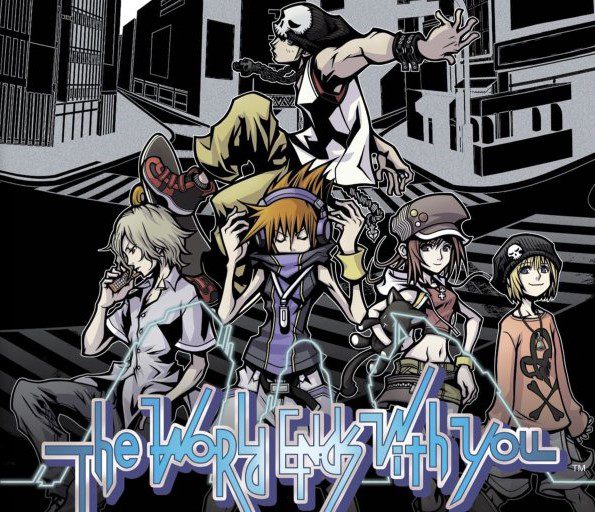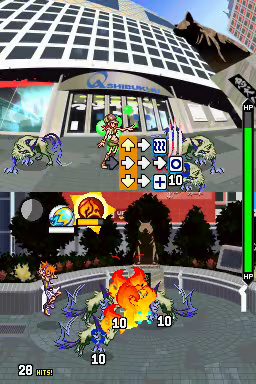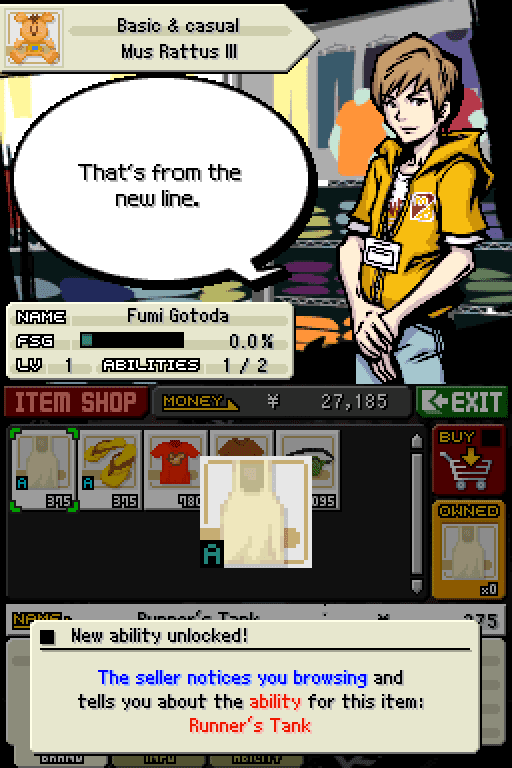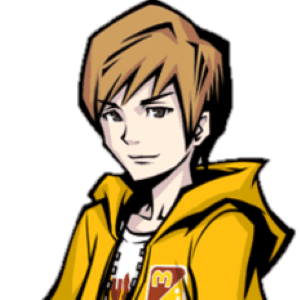I had always thought today’s title would be a milestone article like my 25th review or something. An article touching on my bygone high school days to celebrate all the things gaming has given me, since this game in particular has given me so, so much. But in 2021, this cult classic is poised to make a comeback with the airing of its anime adaptation, still on-going as of this writing, and a full on sequel coming in July. Time will tell if this new horizon cements this game as either the origin of another beloved long running series or a good game tied to an embarrassing revival attempt, but right now let me reflect upon this little JRPG and preserve the memory of what makes it so special to me before it is irrevocably recontextualized by its contemporary continuations. In short, let’s talk about my favorite game.

Co-developed and published by Square Enix and Jupiter, The World Ends With You is a teenage angst therapy simulator released in April 2008 (internationally) for the Nintendo DS. The premise involves an anti-social fifteen year old getting wrapped up in a life or death situation which forces him to learn how to trust others while wielding the psychic powers of trendy clothes. Players interact with the game by exploring Tokyo’s Shibuya district, battling enemies to level up and clear objectives, and managing their characters’ combat capabilities.
Keep in mind that two re-releases of this game exist, The World Ends With You: Solo Remix for mobile devices and The World Ends With You: Final Remix for Nintendo Switch. This review is specifically about the original DS version of the game. I have played about 2/3rds of the mobile version and have never touched the Switch version, and if either of these interest you I recommend doing some research on them before buying as they are quite different. I also strongly recommend you play the DS version, but I understand if you haven’t the means to do so.
The story of The World Ends With You follows Neku Sakuraba, a fiercely isolated and dismissive youth who wakes up in the middle of the Shibuya Station crosswalk completely unseen by the crowds, without any memories, and is branded with a timer on his hand after reading a text message that says: “Reach 104. You have 60 minutes. Fail and face erasure. -The Reapers.” Eventually he learns that he is trapped in Shibuya as a Player in the Reapers’ Game, where he must team up with another Player (in his case, a girl named Shiki Misaki) and survive for seven days while completing missions in order to be liberated. This is about as much as can be shared without dipping into one of the game’s many twists, including some that are open secrets at this point but I refuse to say here just in case (I will mention some things that are spoilery in the warnings section to be safe). What really carries the story of this game is its cast of characters who each have a lot of truly compelling personal problems that are handled (almost universally, but not entirely) with a lot of care, and what’s more is that the characters progress in their development as human beings in a way that feels way more real than most stories. Neku is shown to be at his darkest in chapter two (and I mean DARK) before his character begins to improve, but this does not prevent him from regularly slipping back into old mindsets later down the line and it makes the destination he ends up at feel more earned because of it. All in all the journey of The World Ends With You’s characters is worth the price of admission by itself and makes for one of gaming’s most impactful stories ever. If I had one major complaint about the story overall it would be that the character Beat (who you meet early on) has his inner turmoil resolved through lessons which are healthy in one sense, but are also a little bit at odds with the game’s themes of self-improvement (which to me is fundamental to human nature itself) after some reflection.
So the story itself is about someone struggling to learn how to work with other people, which is common in JRPG writing, but the gameplay of The World Ends With You is what would result if you took that concept and baked it into literally every facet of the mechanics. The game’s combat revolves around controlling Neku and his partner simultaneously and synching their attacks together to defeat the game’s enemies, called the Noise. If the idea of controlling two characters at once sounds difficult, that’s because it is. Neku is controlled entirely through touch controls on the bottom screen, and his partner is commanded by using the d-pad on the top screen. In many ways you are playing two battle systems at once, and yet mastery of this unique combat rewards the player with rhythmic, fast-paced action unlike anything else in the role-playing genre, on top of being thematically resonant. The Noise themselves are varied opponents that keep combat fresh, to the point where even pallet-swapped enemies with extra moves feel less like filler and more like genuine new threats. The only real drawback to the combat design is that the last three chapters of the game become bizarrely inconsistent in difficulty, with scripted story battles ranging from having a gimmick that swings the battle way in your favor to being so hard that lowering the difficulty is more or less an act without shame.

No RPG is without its number-crunching, but The World Ends With You manages to leverage its urban setting to keep the act of stat maintenance interesting. Firstly, Neku’s attacks in combat stem from equipping him with button pins that each correspond to different psychic attacks (called “psychs”) like melee shockwaves, pyrokinesis, and drinking soda to heal, which are done through different touch screen motions. This weapon system succeeds both in providing the player with a ton of different tools to experiment with, and providing a way for the player to avoid using specific stylus motions if they find them uncomfortable. Pins can also be leveled into stronger ones when equipped for extended periods, so the player is additionally rewarded for finding a play style that suits them. The armor system is a bit more traditional when you strip away the fact that it’s literally just buying clothes from department stores, but it is made a little more interesting by the Bravery stat, which determines what clothes the characters are willing to wear, because of course Shiki will be more willing to wear pumps than Neku. These two systems are brought together in the trends system, wherein most pins and articles of clothing are associated with a particular fashion brand and their popularity in the immediate area can cause pins to do more or less damage, but sticking with a loadout will make those brands more popular. This is a really neat system which allows players to weigh between switching gear before fighting in a given zone or tough it out in order to make the pins you want to use more powerful, as well as injecting a bit of interesting social commentary, though I’ve always staunchly avoided caring about fashion trends and found them pretty easy to mitigate.

The World Ends With You is also a bit different from most RPGs in that while grinding for EXP levels up your Bravery and maximum health, the real key to power is eating food, as this not only increases your Sync Rate (helps increase damage overtime if the heroes take turns hitting the enemy) but is one of the only ways to permanently increase attack and defense. This is another system that ties into the overarching themes because some foods give better Sync Rate bonuses but those are wasted if the character dislikes what they were fed, so the player is encouraged to care about their preferences. While there are plenty of other systems I could go over, I’ll end with its most genius system: the “stop playing the game” system. The food system gives characters only so much stomach space per real-time day, and the pins you have equipped acquire level up points through various methods that decides whether it will evolve into a different pin or not, with one of those methods being time elapsed since you last played the game. I’m not foolish enough to think that these systems don’t get time traveled by hardcore players who just want to grind every stat to max, but in principle the system is there to encourage the player to step away from time to time and actually try this mysterious friendship thing these Japanese teenagers keep going on about, all without being too punishing for marathon sessions in practice. In most any other game this sort of mechanic would be an absolute plague, but by some miracle the developers found a way to take this concept and use it in a way that truly commits to the game’s messages, and that is worth just about every commendation I can give.
From a graphics perspective, the HD remasters of the art and sprites found in the game’s re-releases definitely caused this game to show some age with its more jagged linework in places and generally lower fidelity, but The World Ends With You’s basic artistic expression is so strong on its own that it’s probably one of the best looking DS games ever made. The visuals are a combination of manga and graffiti art styles, and they certainly leave an impression. The environments are rendered in bold abstractions that give personality to otherwise simple city streets and characters sport larger than life clothing that make them unmistakable and iconic. Of special mention is the Noise, which have designs so striking and baked into the game’s visual identity that fans have mostly agreed the two series revival projects simply haven’t been able to translate them to three dimensions faithfully. This really was a vision of the early 21st century through the eyes of its hard edged youth culture in the best way possible.
Perhaps even more legendary though is the game’s soundtrack. The musical compositions really leaned into providing music that sounded similar to something a headphones touting teenager like Neku would have played through his MP3, and as a result the soundscape touches on a huge number of genres. Pop, rock, EDM, a touch of rap, and more plays throughout the adventure, each track being memorable in its own way. Even remixes of the same song or the same song sung in Japanese manage to stick out in my mind! Calling, Deja Vu, Transformation, Long Dream, Hybrid, Someday, Twister… there’s just a lot of good music in this game ok?
Lastly I want to touch on the moral wisdom of the game. Ultimately the message I found within the text of this game is this: Opening up to other people is painful and terrifying in a way I cannot even put into words because understanding others is a very difficult and vulnerable position to put oneself in, and The World Ends With You knows this. Despite this, it is a reminder to anyone that struggles with this that unless we face that fear, strive to forge meaningful connections, and be kind to others, our horizons will never expand and we’ll never overcome the challenges that weigh our hearts down. I think of the anxieties I felt moving into high school, yet striving to live honestly and be patient with my peers while I found my place in the world. I think of the way Jesus saw all the cruelty and sin within the hearts of men, and yet He still chose to take our form in the Incarnation to bear the burden of that sin even unto death upon a cross, that He might reach out to every one of us and call us to be united with Him in true Love. This is what makes this game so special to me.
So in summary The World Ends With You is an inspired and uncompromising gem of a game which takes hold of the most simple themes possible and takes them as far as they can go until what it has made is one of the most earnestly cohesive experiences of its time. It may not have been perfect and it definitely is not the most approachable game, but there lies beneath the surface something special worth every minute taken to understand what the game was going for. If anything mentioned here sounded remotely interesting, dust off your old DS or 3DS and get on your way to your nest in the west.
See you in Shibuya.
Scoring: 95%
Gameplay: 5/5
Art and Graphics: 5/5
Music: 5/5
Story: 5/5
Replayability: 4/5
Morality/Parental Warnings
The setting of The World Ends With You heavily features a variety of supernatural elements with little cosmological or theological accuracy. Most characters’ sole means of defending themselves is through the use of psychic powers, with a few other scenes wherein guns are used, albeit not very graphically. The afterlife appears to be totally annihilationist despite the secret reports revealing something akin to Heaven existing. Said reports also reveal that the fallen angel working in the background of the story isn’t all that accurate either. There is one graffiti magic circle that appears in the game. Some female characters wear revealing clothing, which is a shame for Shiki Misaki since she’s a teenager but it does tie into her character arc in an important way. There is one minigame which involves you manipulating a divination board not unlike a watered down ouija board, but it is optional after the first chapter it is used in unless you’re gunning for 100% completion in the post-game. One character is referred to and associated with heavy allusions to God right down to one character capitalizing pronouns when referring to him, despite not even technically being a god within the game’s expanded lore. Foul language is present in a good number of scenes.
